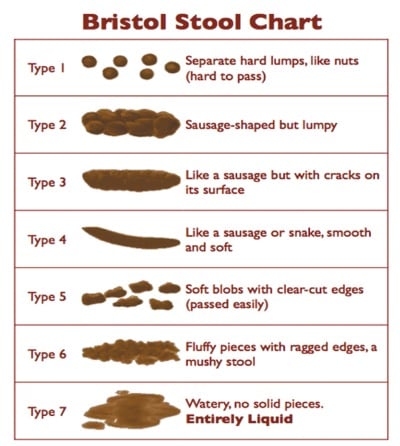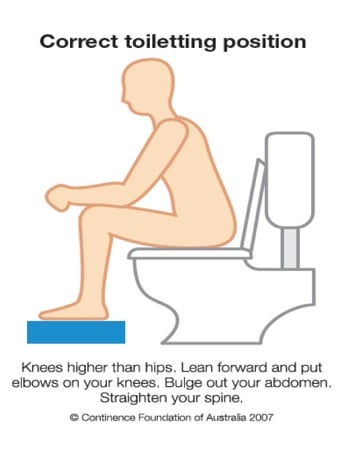|
This fact sheet explains what constipation is and suggests some ideas for improvement and tells you where to get more help. |
Dit Deze folder bevat uitleg over wat obstipatie is en u vindt hierin tevens een aantal tips voor de weg naar genezing. Ook leest u waar u meer te weten kunt komen. |
What is constipation?Constipation is a common disorder where bowel actions ('poo' or faeces) are not easily and/or less frequently passed. Symptoms of constipation include:
|
Wat is obstipatie?Obstipatie, oftewel verstopping, is een veel voorkomende aandoening waarbij stoelgang (‚poepen‘ of ontlasting) moeite kost en/of niet vaak genoeg plaatsvindt. Symptomen van verstopping zijn onder meer:
|
What does being 'Regular' mean?
|
Wat betekent ‚regelmatig‘?
|
What can cause constipation?
|
Waardoor kan verstopping ontstaan?
|
What should your 'poo' look like?Your poo should be light or dark brown, sausage-shaped, soft but firm, easy to pass and with minimal odour. Aim to have a type 3 or type 4 bowel action.  |
Hoe moet uw ‚poep‘ eruit zien?Uw poep hoort licht- of donkerbruin te zijn, is worstvormig, kan gemakkelijk worden geproduceerd en heeft een minimale geur. Streef naar stoelgang type 3 of 4.  |
Common Bowel ProblemsFaecal Impaction - When constipation causes faeces to pack the intestine (digestive tract) so tightly that your normal pushing action in the toilet is not strong enough to push the faeces out. Faecal Incontinence (sometimes referred to as 'soiling') - This is the accidental loss of liquid or solid faeces. This can be due to the bowel (which stores the faeces) being too full, but this may be only one of the causes. Uncontrolled flatus ('wind') is often considered evidence of faecal incontinence. Haemorrhoids (sometimes referred to as 'piles') - This can be the result of straining to have a bowel movement. This strain (similar to heavy lifting) can damage the rectum's veins. This can cause bleeding, soreness and itching. Rectal Prolapse - This occurs when long-term straining causes a small amount of bowel lining to push out from the anus, which is a ring of muscle that opens and closes when we pass a bowel motion. |
Veel voorkomende darmproblemenFecale impactie – Wanneer als gevolg van verstopping de ontlasting zo dicht opeengepakt zit in de darmen (het spijsverteringskanaal), dat uw normale persactie op het toilet onvoldoende is om ontlasting te kunnen produceren. Fecale incontinentie (oftewel ongewild ontlastingsverlies) – Dit is het niet kunnen ophouden van vloeibare of vaste ontlasting. Dit kan onder meer het gevolg zijn van te veel ontlasting in de darmen. Een slechte controle over darmgassen (‚winden‘) wordt vaak beschouwd als teken van fecale incontinentie. Aambeien – Deze kunnen worden veroorzaakt door teveel persen bij het produceren van ontlasting. Deze inspanning (vergelijkbaar met zwaar tillen) kan de bloedvaten in de endeldarm beschadigen. Dit kan bloeden, pijn en jeuk veroorzaken. Rectale verzakking – Men spreekt van een rectale verzakking als een deel van de darmwand als gevolg van langdurig persen via de anus naar buiten komt. De anus is een kringspier die opent en sluit tijdens de stoelgang. |
How constipation affects bladder controlConstipation can cause accidential leakage from your bladder. An overfull bowel will cut down the volume of urine your bladder can hold and you will feel the need to go to the toilet often and in a hurry.  |
De invloed van verstopping op blaascontroleVerstopping kan onvrijwillig urineverlies veroorzaken Een overvolle darm kan op uw blaas drukken, zodat u het gevoel hebt dat u plotseling en vaker moet plassen  |
Here are five ways to keep your bladder and bowel healthy and prevent constipation:Eat well to keep your bowels regular and to have a healthy body weight Eat a healthy diet high in fibre (at least 30g per day). Drink well to prevent constipation and bladder irritation Drink 1.5 -2 Litres(6-8 glasses) of fluid each day unless advised otherwise by your doctor. Fluid is water, fruit juice, tea, coffee, milk, soup, jellies and icecream. Exercise daily to prevent constipation and keep a healthy body weight Keep your pelvic floor strong for good bladder and bowel control Request a pelvic floor muscle exercise leaflet by calling the National Continence Helpline 1800 33 00 66. Toileting habits - Go to the toilet as soon as you need to and empty your bowel fully. Remember to relax. |
Hieronder staan vijf manieren om uw blaas en darmen gezond te houden en verstopping te voorkomen:Eet goed, om uw stoelgang regelmatig en uw gewicht gezond te houden Zorg voor een gezond voedingspatroon met veel vezels (ten minste 30 g per dag). Drink goed om verstopping en blaasirritatie te voorkomen Drink 1,5 - 2 liter (6-8 glazen) vloeistof per dag, tenzij uw arts anders adviseert. Vloeistof is water, vruchtensap, thee, koffie, melk, soep, gelei en ijs. Zorg elke dag voor voldoende beweging om verstopping te voorkomen en een gezond lichaamsgewicht te behouden Houd uw bekkenbodemspieren sterk voor een goede blaas- en darmcontrole Vraag een formulier met oefeningen voor de bekkenbodemspieren aan bij de Nationale Continentie-hulplijn 1800 33 00 66. Toiletgewoonten – Ga naar het toilet als u aandrang voelt en zorg dat uw darmen helemaal leeg zijn. Neem de tijd. |
|
Check your toileting postion:
 |
Let op uw toilethouding:
 |
Laxatives
|
Let op uw toilethouding:
|
|
There are three types of laxatives:
|
Er zijn drie soorten laxeermiddelen:
|
|
If constipation is severe or continuing, go to your Doctor. |
Raadpleeg uw arts bij ernstige of voortdurende verstopping. |
Who can help?The first step to improving your bowel control is to have a full continence assessment carried out by a health professional. |
Wie kan helpen?De eerste stap om uw darmbeheersing te verbeteren is een volledige continentiebeoordeling door een gezondheidsdeskundige. |
For more informationThere are a range of health professionals who can help you deal with constipation.
|
Voor meer informatieEr zijn diverse gezondsheidsdeskundigen die u kunnen helpen als u last hebt van verstopping.
|
Constipation and Bowel Control in Dutch
Obstipatie en darmcontrole
Browse and download our factsheets in Dutch
Last Updated: Fri 30, Jul 2021
Last Reviewed: Tue 17, Mar 2020

